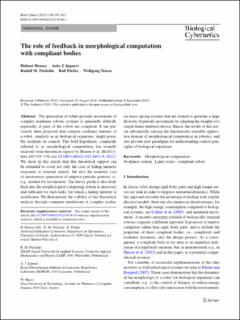Bitte benutzen Sie diese Kennung, um auf die Ressource zu verweisen:
https://doi.org/10.21256/zhaw-1667| Publikationstyp: | Beitrag in wissenschaftlicher Zeitschrift |
| Art der Begutachtung: | Peer review (Publikation) |
| Titel: | The role of feedback in morphological computation with compliant bodies |
| Autor/-in: | Hauser, Helmut Ijspeert, Auke J. Füchslin, Rudolf Marcel Pfeifer, Rolf Maass, Wolfgang |
| DOI: | 10.21256/zhaw-1667 10.1007/s00422-012-0516-4 |
| Erschienen in: | Biological Cybernetics |
| Band(Heft): | 106 |
| Heft: | 10 |
| Seite(n): | 595 |
| Seiten bis: | 613 |
| Erscheinungsdatum: | 2012 |
| Verlag / Hrsg. Institution: | Springer |
| ISSN: | 0340-1200 1432-0770 |
| Sprache: | Englisch |
| Schlagwörter: | Morphological computation; Nonlinear system; Limit cycles; Compliant robots |
| Fachgebiet (DDC): | 005: Computerprogrammierung, Programme und Daten |
| Zusammenfassung: | The generation of robust periodic movements of complex nonlinear robotic systems is inherently difficult, especially, if parts of the robots are compliant. It has previously been proposed that complex nonlinear features of a robot, similarly as in biological organisms, might possibly facilitate its control. This bold hypothesis, commonly referred to as morphological computation, has recently received some theoretical support by Hauser et al. We show in this article that this theoretical support can be extended to cover not only the case of fading memory responses to external signals, but also the essential case of autonomous generation of adaptive periodic patterns, as, e.g., needed for locomotion. The theory predicts that feedback into the morphological computing system is necessary and sufficient for such tasks, for which a fading memory is insufficient. We demonstrate the viability of this theoretical analysis through computer simulations of complex nonlinear mass-spring systems that are trained to generate a large diversity of periodic movements by adapting the weights of a simple linear feedback device. Hence, the results of this article substantially enlarge the theoretically tractable application domain of morphological computation in robotics, and also provide new paradigms for understanding control principles of biological organisms. |
| Weitere Angaben: | Erworben im Rahmen der Schweizer Nationallizenzen (www.nationallizenzen.ch) |
| URI: | https://digitalcollection.zhaw.ch/handle/11475/2791 |
| Volltext Version: | Publizierte Version |
| Lizenz (gemäss Verlagsvertrag): | Lizenz gemäss Verlagsvertrag |
| Gesperrt bis: | 2018-01-01 |
| Departement: | School of Engineering |
| Enthalten in den Sammlungen: | Publikationen School of Engineering |
Dateien zu dieser Ressource:
| Datei | Beschreibung | Größe | Format | |
|---|---|---|---|---|
| 2012_Hauser_The role of feedback_Biological Cybernetics.pdf | 1.53 MB | Adobe PDF |  Öffnen/Anzeigen |
Zur Langanzeige
Hauser, H., Ijspeert, A. J., Füchslin, R. M., Pfeifer, R., & Maass, W. (2012). The role of feedback in morphological computation with compliant bodies. Biological Cybernetics, 106(10), 595–613. https://doi.org/10.21256/zhaw-1667
Hauser, H. et al. (2012) ‘The role of feedback in morphological computation with compliant bodies’, Biological Cybernetics, 106(10), pp. 595–613. Available at: https://doi.org/10.21256/zhaw-1667.
H. Hauser, A. J. Ijspeert, R. M. Füchslin, R. Pfeifer, and W. Maass, “The role of feedback in morphological computation with compliant bodies,” Biological Cybernetics, vol. 106, no. 10, pp. 595–613, 2012, doi: 10.21256/zhaw-1667.
HAUSER, Helmut, Auke J. IJSPEERT, Rudolf Marcel FÜCHSLIN, Rolf PFEIFER und Wolfgang MAASS, 2012. The role of feedback in morphological computation with compliant bodies. Biological Cybernetics. 2012. Bd. 106, Nr. 10, S. 595–613. DOI 10.21256/zhaw-1667
Hauser, Helmut, Auke J. Ijspeert, Rudolf Marcel Füchslin, Rolf Pfeifer, and Wolfgang Maass. 2012. “The Role of Feedback in Morphological Computation with Compliant Bodies.” Biological Cybernetics 106 (10): 595–613. https://doi.org/10.21256/zhaw-1667.
Hauser, Helmut, et al. “The Role of Feedback in Morphological Computation with Compliant Bodies.” Biological Cybernetics, vol. 106, no. 10, 2012, pp. 595–613, https://doi.org/10.21256/zhaw-1667.
Alle Ressourcen in diesem Repository sind urheberrechtlich geschützt, soweit nicht anderweitig angezeigt.